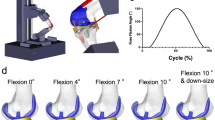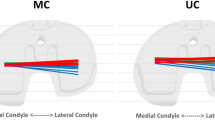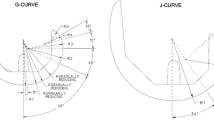Abstract
Purpose
Total knee arthroplasty (TKA) for valgus knee osteoarthritis is challenging. Although overcorrection in TKA for valgus knee osteoarthritis is recommended, supportive data based on biomechanics have rarely been reported. The purpose of this study was to elucidate whether coronal rotation of the femoral compartment causes abnormal kinematics with or without medial looseness.
Methods
Multi- and single-radius posterior-stabilised TKA implants were utilised in a computer simulation. A total of 4 mm of slack were provided in the medial collateral ligament (MCL) with varus or valgus position of the femoral component to simulate the context of valgus knee osteoarthritis. Kinematics during gait and squatting activities were evaluated in each condition.
Results
During squatting, medial looseness and valgus replacement caused anterior translation of the medial femoral component in mid-flexion in the multi-radius implant. In the worst condition (7° valgus replacement with MCL looseness), there was rapid anterior translation in the multi-radius implant, and moderate anterior translation in the single-radius implant. Although medial looseness alone did not cause abnormal kinematics during gait, the worst condition exhibited an anterior translation to 4.9 mm in the multi-radius implant. This worst condition also exhibited a marked lift-off of 8.0 and 2.9 mm in the multi- and single-radius implants, respectively. Varus position caused little abnormal kinematics even with MCL looseness.
Conclusion
Valgus, not varus position of the femoral component caused abnormal kinematics with MCL looseness. To avoid valgus position, the safety target angle of femoral component would be slight varus rather than neutral in valgus knee OA.






Similar content being viewed by others
References
Anderson KC, Buehler KC, Markel DC (2005) Computer assisted navigation in total knee arthroplasty: comparison with conventional methods. J Arthroplasty 20:132–138
Blankevoort L, Kuiper JH, Huiskes R, Grootenboer HJ (1991) Articular contact in a three-dimensional model of the knee. J Biomech 24:1019–1031
Chua KHZ, Chen Y, Lingaraj K (2014) Navigated total knee arthroplasty: is it error-free? Knee surgery, sports traumatology. Arthroscopy 22:643–649
Collados-Maestre I, Lizaur-Utrilla A, Gonzalez-Navarro B, Miralles-Muñoz FA, Marco-Gomez L, Lopez-Prats FA, Gil-Guillen V (2017) Better functional outcome after single-radius TKA compared with multi-radius TKA. Knee Surg Sports Traumatol Arthrosc 25:3508–3514
Dennis D (2001) Femoral condylar lift-off in vivo in total knee arthroplasty. J Bone Jt Surg Br 83:33–39
Dennis DA, Komistek RD, Kim RH, Sharma A (2010) Gap balancing versus measured resection technique for total knee arthroplasty. Clin Orthop Relat Res 468:102–107
Elkus M, Ranawat CS, Rasquinha VJ, Babhulkar S, Rossi R, Ranawat AS (2004) Total knee arthroplasty for severe valgus deformity. Five to fourteen-year follow-up. J Bone Jt Surg Am 86-A:2671–2676
Favorito P (2002) Total knee arthroplasty in the valgus knee. J Am Acad Orthop Surg 10:16–24
Hino K, Ishimaru M, Iseki Y, Watanabe S, Onishi Y, Miura H (2013) Mid-flexion laxity is greater after posterior-stabilised total knee replacement than with cruciate-retaining procedures: a computer navigation study. Bone Jt J 95-B:493–497
Hino K, Kutsuna T, Oonishi Y, Watamori K, Kiyomatsu H, Iseki Y, Watanabe S, Ishimaru Y, Miura H (2017) Assessment of the midflexion rotational laxity in posterior-stabilized total knee arthroplasty. Knee Surg Sports Traumatol Arthrosc 25:3495–3500
Kang K-T, Kwon SK, Son J, Kwon O-R, Lee J-S, Koh Y-G (2018) The increase in posterior tibial slope provides a positive biomechanical effect in posterior-stabilized total knee arthroplasty. Knee Surg Sports Traumatol Arthrosc 26:3188–3195
Komistek R (2002) In vivo comparison of femorotibial contact positions for press-fit posterior stabilized and posterior cruciate-retaining total knee arthroplasties. J Arthroplasty 17:209–216
Koskinen E, Remes V, Paavolainen P, Harilainen A, Sandelin J, Tallroth K, Kettunen J, Ylinen P (2011) Results of total knee replacement with a cruciate-retaining model for severe valgus deformity—a study of 48 patients followed for an average of 9 years. Knee 18:145–150
Kuriyama S, Ishikawa M, Furu M, Ito H, Matsuda S (2014) Malrotated tibial component increases medial collateral ligament tension in total knee arthroplasty. J Orthop Res 32:1658–1666
Lee D-H, Padhy D, Park J-H, Jeong W-K, Park J-H, Han S-B (2011) The impact of a rectangular or trapezoidal flexion gap on the femoral component rotation in TKA. Knee Surg Sports Traumatol Arthrosc 19:1141–1147
Lee SY, Matsui N, Kurosaka M, Komistek RD, Mahfouz M, Dennis DA, Yoshiya S (2005) A posterior-stabilized total knee arthroplasty shows condylar lift-off during deep knee bends. Clin Orthop Relat Res 435:181–184
Matsuda S, Ito H (2015) Ligament balancing in total knee arthroplasty-medial stabilizing technique. Asia Pac J Sports Med Arthrosc Rehabil Technol 2:108–113
Nakamura S, Ito H, Yoshitomi H, Kuriyama S, Komistek RD, Matsuda S (2015) Analysis of the flexion gap on in vivo knee kinematics using fluoroscopy. J Arthroplasty 30:1237–1242
Okazaki K, Miura H, Matsuda S, Takeuchi N, Mawatari T, Hashizume M, Iwamoto Y (2006) Asymmetry of mediolateral laxity of the normal knee. J Orthop Sci 11:264–266
Ramappa M (2015) Midflexion instability in primary total knee replacement: a review. SICOT J 1:24
Ritter MA, Davis KE, Davis P, Farris A, Malinzak RA, Berend ME, Meding JB (2013) Preoperative malalignment increases risk of failure after total knee arthroplasty. J Bone Jt Surg Am 95:126–131
Rossi R, Rosso F, Cottino U, Dettoni F, Bonasia DE, Bruzzone M (2014) Total knee arthroplasty in the valgus knee. Int Orthop 38:273–283
Shalhoub S, Moschetti WE, Dabuzhsky L, Jevsevar DS, Keggi JM, Plaskos C (2018) Laxity profiles in the native and replaced knee—application to robotic-assisted gap-balancing total knee arthroplasty. J Arthroplasty 33:3043–3048
Stoddard JE, Deehan DJ, Bull AMJ, McCaskie AW, Amis AA (2013) The kinematics and stability of single-radius versus multi-radius femoral components related to mid-range instability after TKA. J Orthop Res 31:53–58
Tanaka Y, Nakamura S, Kuriyama S, Ito H, Furu M, Komistek RD, Matsuda S (2016) How exactly can computer simulation predict the kinematics and contact status after TKA? Examination in individualized models. Clin Biomech (Bristol Avon) 39:65–70
Tokuhara Y, Kadoya Y, Nakagawa S, Kobayashi A, Takaoka K (2004) The flexion gap in normal knees. An MRI study. J Bone Jt Surg Br 86:1133–1136
Wellman SS, Klement MR, Queen RM (2017) Performance comparison of single-radius versus multiple-curve femoral component in total knee arthroplasty: a prospective, randomized study using the lower quarter Y-balance test. Orthopedics 40:e1074–e1080
Yang NH, Nayeb-Hashemi H, Canavan PK, Vaziri A (2010) Effect of frontal plane tibiofemoral angle on the stress and strain at the knee cartilage during the stance phase of gait. J Orthop Res 28:1539–1547
Acknowledgements
The authors thanked Drs. Yoshihisa Tanaka and Mutsumi Watanabe for their technical support in a computer simulation.
Funding
There is no funding source for this study.
Author information
Authors and Affiliations
Contributions
KN carried out designing the study, data acquisition with computer simulation, drafted the manuscript, SK, SN and YM carried out data acquisition with computer simulation, HI participated in analysis and interpretation, SM conceived the study and helped to draft the manuscript. All authors read and approved the final manuscript.
Corresponding author
Ethics declarations
Conflict of interest
SN and SM received a research grant from Kyocera and SM received research grants from Zimmer-Biomet. Neither of the companies had any influence on this study.
Ethical approval
This study was approved by the ethics committee of Kyoto University Hospital (R0980).
Informed consent
Written informed consent was obtained to create validated bone model.
Rights and permissions
About this article
Cite this article
Nishitani, K., Kuriyama, S., Nakamura, S. et al. Valgus position of the femoral component causes abnormal kinematics in the presence of medial looseness in total knee arthroplasty: a computer simulation model of TKA for valgus knee osteoarthritis. Knee Surg Sports Traumatol Arthrosc 27, 2051–2060 (2019). https://doi.org/10.1007/s00167-018-5264-0
Received:
Accepted:
Published:
Issue Date:
DOI: https://doi.org/10.1007/s00167-018-5264-0




